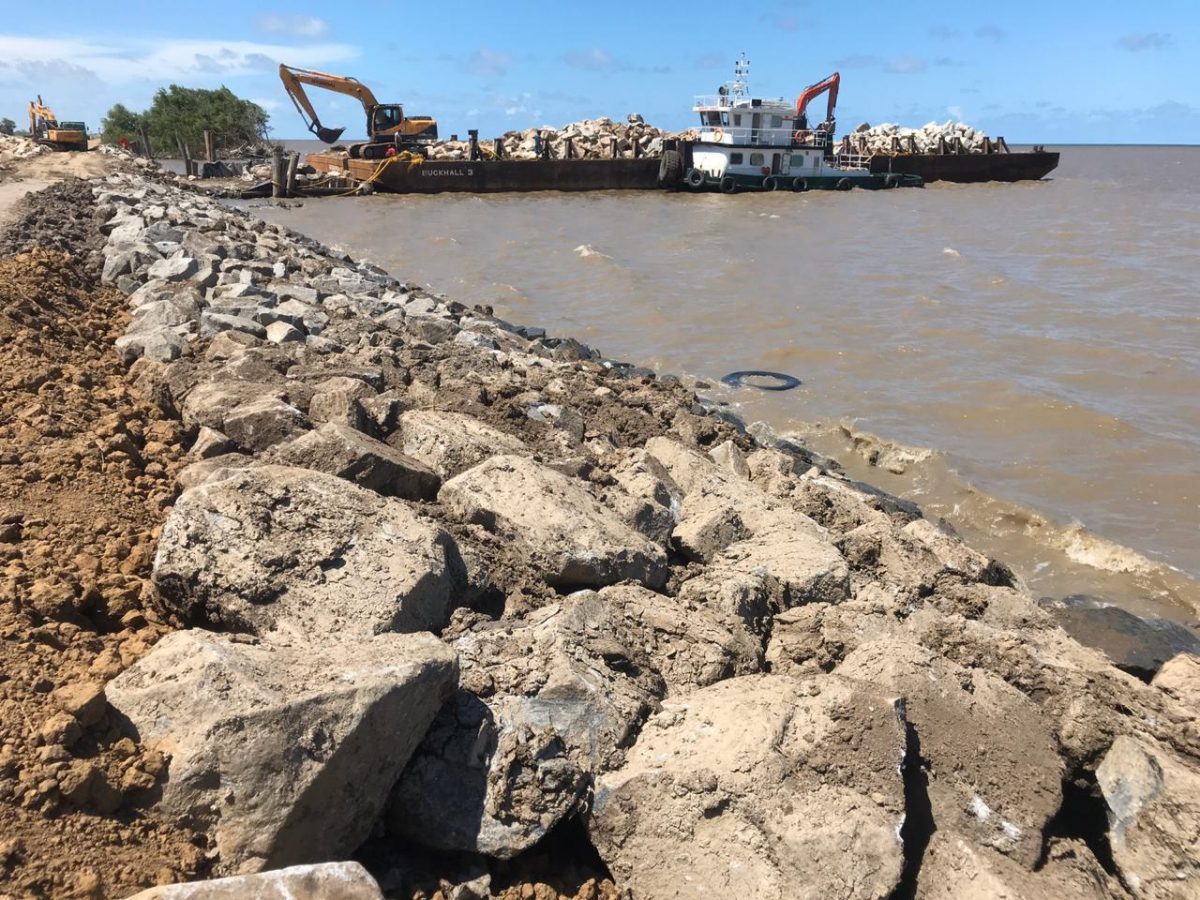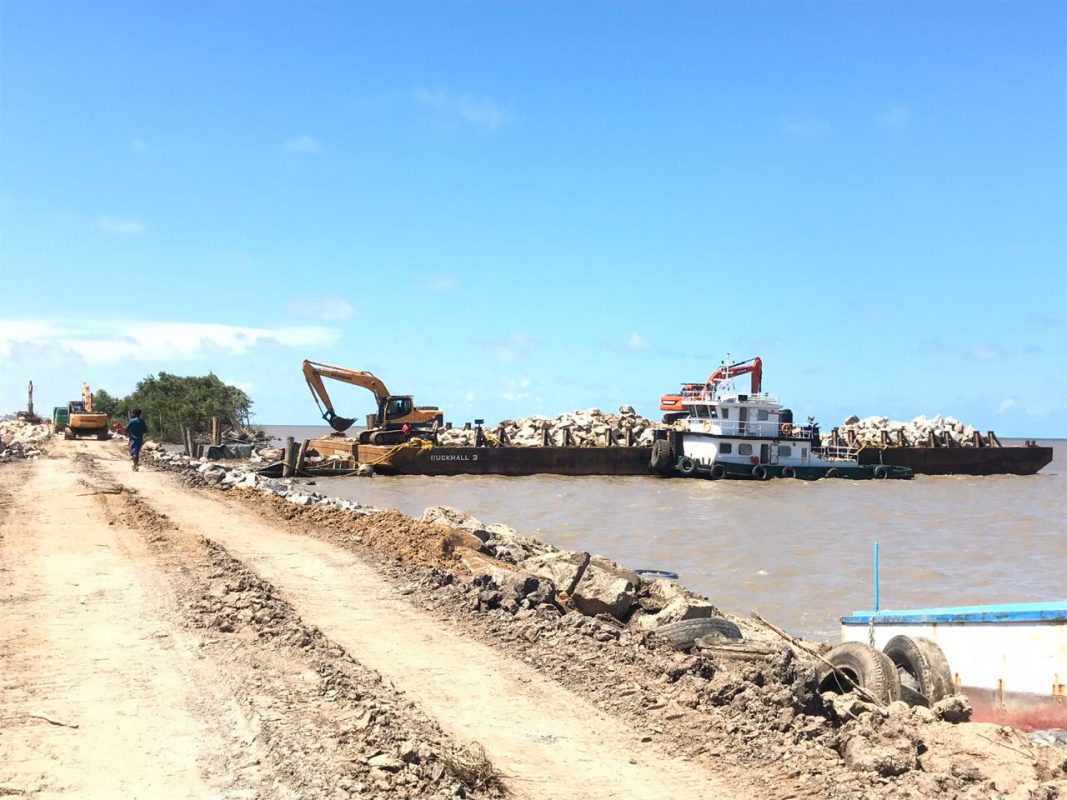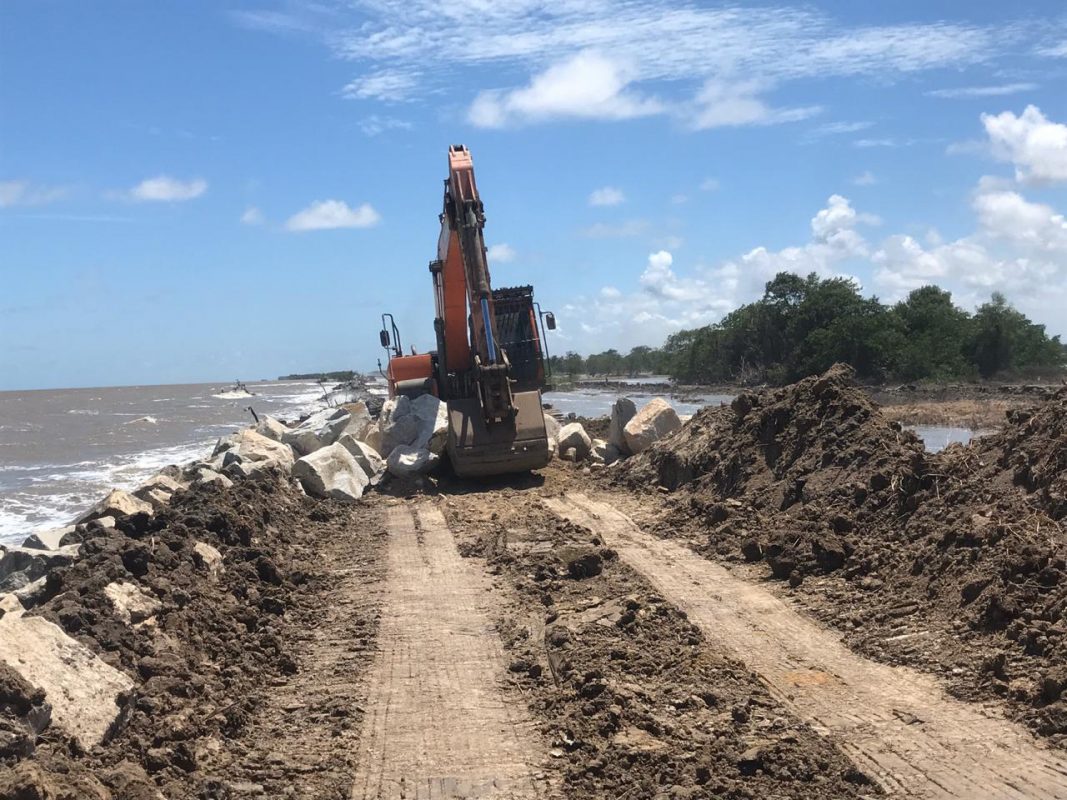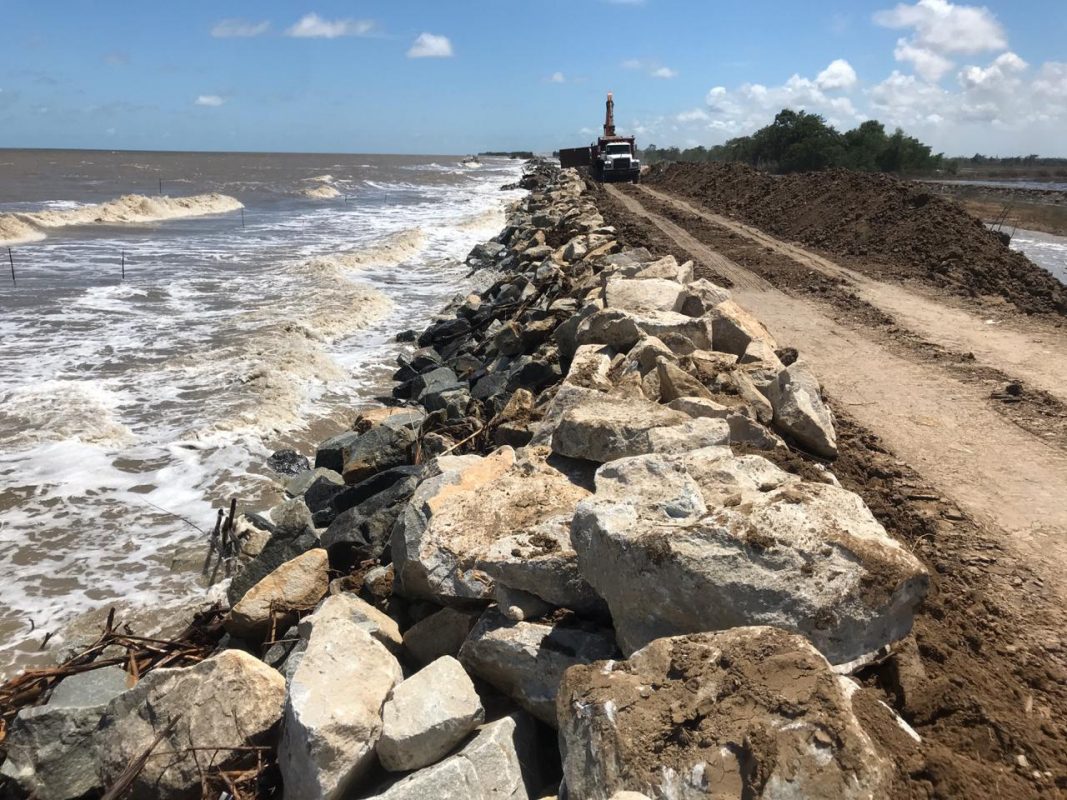With more spring tides forecast from today, the Sea and River Defence Department of the Ministry of Public Infrastructure (MoPI) is assuring that it will seek to cushion the impact of expected flooding in coastal communities, including those still vulnerable due to exposed sections of the Mahaicony sea defence.
Government has been executing emergency works since the last spring tide period in September and was aiming to complete works in time for the next spring tide event, which starts today. Some 18,000 tonnes of boulders were needed to be placed along the breached zone between Dantzig and Fairfield. So far, approximately 6,000 tonnes of boulders have been placed and works are still ongoing.
A statement from MoPI yesterday explained that the Sea and River Defence Department is currently executing emergency works to restore heavily eroded and breached sections of the earthen embankment by constructing a rock armour facing on the seaward slope as an erosion control measure.
Civil engineering companies BK International and A&S General Contrac-tors Incorporated over the past weeks have been working day and night to repair the breached sea defence, measuring 3km, between Dantzig and Fairfield.
BK international is currently executing works at Dantzig, while A&S General Contractors Incor-porated is working at Fairfield.
According to Chief Sea and River Defence Officer Kevin Samad, works being executed are financed through a contingency allocation made by the Ministry of Finance. “These resources are being utilised to engage multiple contractors … to achieve faster implementation,” he was quoted as saying by the ministry.
Samad added that while the works being executed are a medium-term solution, in the future they will have to look at implementing a more resilient flood protecting plan.
“…Future adaptation of the sea defences will be required to achieve a more resilient flood protection scheme. This overall integrated and strategic approach will require that consideration be given to implementing foreshore stabilization measures and landward offsets that would enable adequate retention spaces to absorb overtopping discharge when extreme events are experienced,” he said.
‘Accelerating the work’
During a visit, this newspaper yesterday observed that materials to execute emergency works at the sites were being delivered regularly. Due to the ferocious waves at Dantzig, barges transporting boulders are unable to dock. As a result, trucks have been transporting boulders and sand to the location.
Troy Krishna, a supervisor at the Dantzig worksite, explained that they have completed construction of 300 feet of rip rap sea defences, measuring approximately 10 to 12 feet in height.
He noted that they also had to build the mud dam higher to prevent overtopping from the Atlantic.
“As we are working here, we are building the dam and the rip rap together. At every low tide we are accelerating the work because that is when we can work from the ground up. So we have to be working day and night. Trucks are bringing the boulders from Georgetown and off-loading so we can have enough materials to use when we start to work,” he explained.
Also, excavators are working daily to rebuild the access road leading to the sea defences at Dantzig to allow easy access by the heavy-duty vehicles transporting materials.
Krishna noted that workers have been working around the clock to complete the construction of the defence but given the challenges they have to be cautious. It is unclear when the works will be completed as he explained that the weather is a vital factor in determining completion.
Meanwhile, at Fairfield, where the Atlantic current is accommodating, barges filled with boulders arrive daily, berthing at a makeshift dock and are off-loaded. A similar makeshift dock is expected to be constructed at Dantzig to allow barges with boulders to dock at the site.
Over the past weeks, the unrelenting waves sank three tugs, resulting in the delay of the construction of the defences. Despite being anchored in the right position, the powerful waves moved the tugs from their anchorage points.
A worker told Stabroek News that over 150 feet of the rip rap defences have been completed. He explained that they too have been working day and night to construct the defences.
He also noted that they work during the low tide to execute their work. He said Fairfield is not affected like Dantzig, however they have to “do as much work as we can when the tide is low because you can never tell what would happen if the situation changes.”
The worker said with barges filled to capacity arriving with boulders they would work to offload them and store material for work while another barge is en route.
This newspaper observed that acres of rice land remained under water yesterday as a result of the towering tides last month.
A Department of Public Information report stated yesterday that the National
Drainage and Irrigation Authority (NDIA) has been working along with the Sea and River Defence Department and has positioned two diesel pumps at Cottage and one at Dantzig. By the end of the week, another pump will be set up to Dantzig, bringing the total drainage capacity to four pumps, the report said.
These pumps will discharge water from the Bellamy Canal into the Atlantic Ocean. To complement these efforts, the Mahaica/Woodlands sluice will be fully operational during low tides to ensure maximum drawdown of water from the Bellamy Canal.
NDIA and the Ministry have also empoldered many of the rice lands within the Dantzig to Fairfield area, in addition to the access dam leading to Dantzig foreshore to reduce the chances of heavy flooding in the residential areas, DPI reported.
‘Notable increase’
The MoPI statement reiterated that the Mahaicony sea defences have been impacted by the cyclic erosion of the foreshore and natural depletion of the mangrove forest, which have caused the breaches along the coast. “The shoreline between Fairfield and Dantzig has become exposed to intense wave impact causing significant overtopping to occur in a number of sections and some sections of the embankment were completely breached during the last spring tide period,” the statement added.
Samad said “the intensity of erosion and the extensiveness of the foreshore impacts have not been experienced along a localised section of the Guyana Coast in recent years and there was a notable increase of the nearshore wave energy along the Mahaicony shoreline.”
Samad explained that this has been a contributory factor to the severity and rapid rate of the erosion experienced along the foreshore and embankment.
The Public Infrastructure Ministry has advised that the upcoming spring tide period will be one of the “most pronounced” for 2019 and will likely impact a number of vulnerable stretches of sea defences.
Samad, in the release, highlighted that though a significant amount of progress has been made in reinstating sections of the Mahaicony sea defences to a reasonable degree, several exposed sections of embankment still exist. Some sections of embankment which were previously reinstated have been compromised and would need to be reinforced and as a result, some level of overtopping is expected during this spring tide event.
With this, the Ministry assured that the Sea and River Defence Department “will continue to actively pursue the required measures to mitigate the impacts of flooding on coastal communities.”
Residents of low-lying coastal communities are advised to take the needed precautions during the remainder of the spring tide period, the ministry said.
Residents living along the coastal belt of regions 2, 3, 4, 5, and 6 have been advised by the Civil Defence Commission (CDC) to take all necessary steps to minimise damage to property and to prevent health hazards, DPI said.







